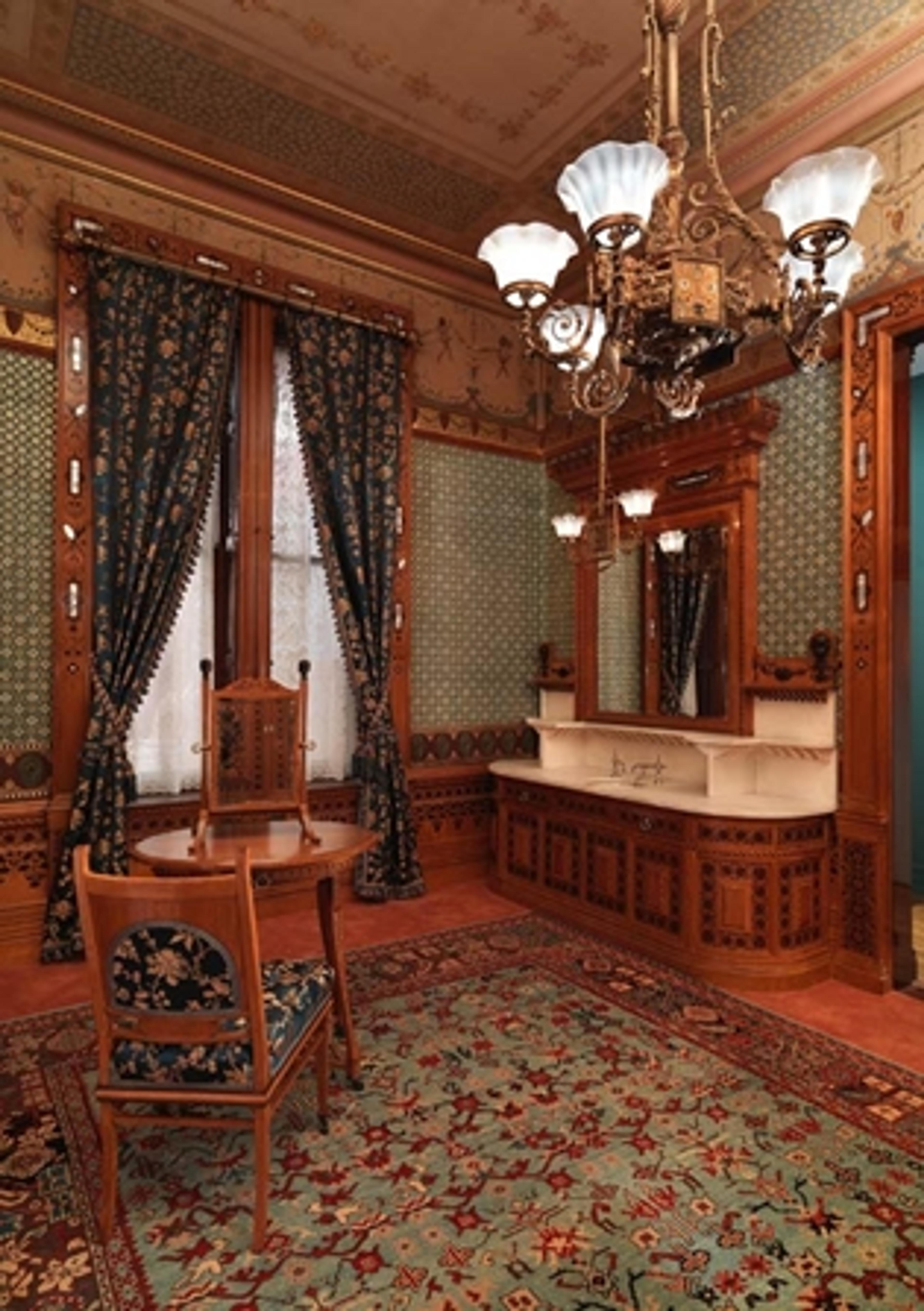Inspired by the Worsham-Rockefeller Dressing Room: "Gallery 742"

George A. Schastey & Co. (1873–97). Worsham-Rockefeller Dressing Room, New York City, 1881–82. The Metropolitan Museum of Art, New York, Gift of The Museum of the City of New York, 2008 (2009.226.1–19a–f)
«There are many sumptuous details and spectacular nuances in the Met's newest American historic interior, the Worsham-Rockefeller Dressing Room (gallery 742). It is a stunning dressing chamber and a fine place to let your imagination go wild: What would it have been like to have that dressing room to yourself, and design it to your every specification? Part of the fun of this particular gallery is the opportunity to just gaze at, or peep a little into, such an intimate room. (Here's a tip for visitors: a window into the dressing room, located in the adjacent gallery 746, provides the most alluring view.)»
The Worsham-Rockefeller Dressing Room represents a piece of the history of Arabella "Belle" Worsham (later Huntington; ca. 1850–1924), a woman as captivating as her surroundings suggest. A noted art collector and philanthropist, she was a teenage single mother when she first arrived in New York City before swiftly rising to the rank of high New York City society. Worsham herself commissioned the room for her home on West 54th Street, ultimately designing, for her personal use, one of the most extraordinary dressing rooms in the history of the Gilded Age.
This compelling story inspired MetLiveArts to explore a new platform for experiencing this room, one that gives the gallery a literal narrative and creates a singular energy in the space: a podcast. MetLiveArts commissioned Nate DiMeo, the creator of The Memory Palace podcast, to explore the gallery and produce a nonfiction episode that reveals the sumptuous details of Arabella's dressing room. "Gallery 742," the seven-minute podcast DiMeo created—which includes an original score composed by Jimmy LaValle of the Album Leaf—is currently available for download and is intended to be heard while visiting the gallery as an Audio Guide stop.
DiMeo's Memory Palace podcast regularly explores intriguing topics and people plucked right from history, and in "Gallery 742" he lyrically weaves Worsham's story into an absorbing, bite-sized episode, accompanied by subtle and expertly composed music. While the podcast episode is revealing, entertaining, and masterfully produced, one mustn't forget that the Worsham-Rockefeller Dressing Room is a work of art in a museum. So to tackle the project, DiMeo jumped right into his research, which he explained to me in a recent email exchange.
Left: George A. Schastey & Co. (1873–97). Worsham-Rockefeller Dressing Room, New York City, 1881–82. The Metropolitan Museum of Art, New York, Gift of The Museum of the City of New York, 2008 (2009.226.1–19a–f)

Meryl Cates: How did you research this podcast episode and Arabella's story?
Nate DiMeo: With my podcast, Memory Palace, I've got to lone-wolf the research. With this project I felt incredibly lucky to be able to tap into the extraordinary resources that the folks at the Met developed while pulling together the [Artistic Furniture of the Gilded Age] exhibition, and overseeing the relocation and new presentation of the dressing room. Photos upon photos upon photos, and references upon references upon references—all at my fingertips thanks to their hard (and remarkable) work.
But the most fun parts of my research and, in some ways, the most useful in terms of really finding a story to tell within all the facts were long discussions with people who knew and loved the room itself. I got to talk extensively with a curator [Alice Cooney Frelinghuysen, the Anthony W. and Lulu C. Wang Curator of American Decorative Arts in The American Wing] while standing in the room-in-progress, and later with Shelly M. Bennett, the former curator of The Huntington Library in the Los Angeles area.
Meryl Cates: How did you pinpoint exactly which details of the dressing room you would verbally illustrate? Was it hard to narrow it down, or did these design elements immediately emerge as important?
Nate DiMeo: My general M.O. with The Memory Palace is this: I come across something from the past—in a novel, during a museum visit, in a documentary, in some listicle on some website written by some unpaid intern toiling away at a content farm, wherever—that moves me, that makes me want to know more, and I go off and research it. The writing and production process, in a very real way, is all about me figuring out how to move the listener in the same way that I was moved.
Meryl Cates: How long did you work on this particular episode, from research to production?
Nate DiMeo: It was a fits-and-starts process over several months. It took me quite a long time, as it often does, to really figure out what the story was about. In this case, to figure out that this would be a story about her becoming the woman she would eventually become. Placing her in time, within this specific place. Once I had that, the writing was labored, but relatively quick.
Related Links
Artistic Furniture of the Gilded Age, on view December 15, 2015–May 1, 2016
MetLiveArts—Podcast: Gallery 742
Meryl Cates
Meryl Cates is a senior publicist in the Communications Department.